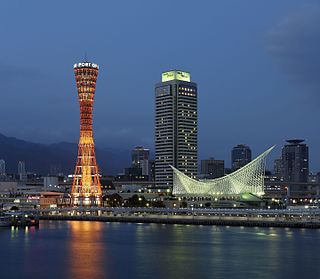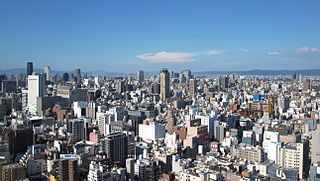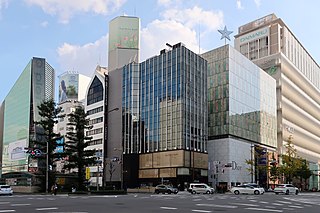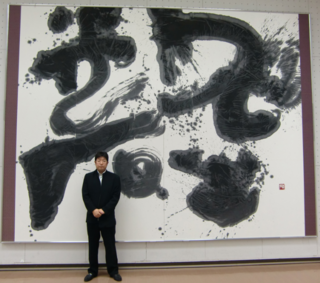
Kobe, officially Kobe City, is the capital city of Hyōgo Prefecture, Japan. With a population around 1.5 million, Kobe is Japan's seventh-largest city and the third-largest port city after Tokyo and Yokohama. It is located in the Kansai region, which makes up the southern side of the main island of Honshū, on the north shore of Osaka Bay. It is part of the Keihanshin metropolitan area along with Osaka and Kyoto. The Kobe city centre is located about 35 km (22 mi) west of Osaka and 70 km (43 mi) southwest of Kyoto.

Umeda Station is a major railway station in Kita-ku in the northern commercial center of Osaka, Japan. It is the busiest station in western Japan, serving 2,343,727 passengers daily in 2005.

Ōsaka Station is a major railway station in the Umeda district of Kita-ku, Osaka, Japan, operated by West Japan Railway Company. It forms as one of the city's main railway terminals to the north, the other being Shin-Ōsaka.

Chūō-ku is one of 24 wards of Osaka, Japan. It has an area of 8.88 km2, and a population of 60,085. It houses Osaka's financial district, as well as the Osaka Prefecture offices and principal shopping and tourist areas.

Shinsaibashi (心斎橋) is a district in the Chūō-ku ward of Osaka, Japan and the city's main shopping area. At its center is Shinsaibashi-suji (心斎橋筋), a covered shopping street, that is north of Dōtonbori and Sōemonchō, and parallel and east of Mido-suji street. Associated with Shinsaibashi, and west of Mido-suji street, is Amerika-mura, an American-themed shopping area and center of Osaka's youth culture. Major stores and boutiques concentrates are found around the area. Shinsaibashi is easily accessed via the subway.

Takashimaya Company, Limited is a Japanese multinational corporation operating a department store chain carrying a wide array of products, ranging from wedding dresses and other apparel to electronics and flatware. It has more than 12 branches strategically located in 2 regions, and 4 international branches around Asia.

Nishi-Umeda Station is the terminus railway station of the Osaka Metro Yotsubashi Line in Umeda, Kita-ku, Osaka, Japan, close to Herbis OSAKA and Herbis ENT operated by Hanshin Electric Railway Co., Ltd. and the two Hilton Plazas.

Higashi-Umeda Station is a railway station on the Osaka Metro Tanimachi Line in Umeda, Kita-ku, Osaka, Japan. The station is located along Whity Umeda.

Shinsaibashi Station is a metro station on the Osaka Metro located in Shinsaibashi, Chūō-ku, Osaka, Japan.

JODX-DTV, branded as Kansai TV or Kantele (カンテレ), is the Kansai region key station of the Fuji News Network (FNN) and Fuji Network System (FNS), owned-and-operated by the Kansai Television Co. Ltd.. Its studios and headquarters are located in Osaka and the broadcaster is an affiliate company of the Hankyu Hanshin Holdings Group, part of the wider Hankyu Hanshin Toho Group.

JOIX-DTV, branded as Yomiuri TV, is the Kansai region flagship station of the Nippon News Network and the Nippon Television Network System, owned by the Yomiuri Telecasting Corporation, itself partially controlled by the eponymous Yomiuri Shimbun Holdings, Japan's largest media conglomerate; Yomiuri TV forms part of Yomiuri's main television broadcasting arm alongside Kantō region flagship Nippon Television, which owns a 15.89% share in the company. Founded as New Osaka Television Co. on February 13, 1958, and renamed Yomiuri Telecasting Corporation on August 1, the station started broadcasting on August 28 as the first TV station to be affiliated with Nippon Television Network Corporation. Its studios are located in the Osaka Business Park district of Osaka.

Sun Television Co., Ltd. is a commercial television station headquartered in Kobe, Hyōgo Prefecture, Japan, and a member of the Japanese Association of Independent Television Stations (JAITS).

Department stores in Japan are referred to as hyakkaten or depāto (デパート), an alteration of the English term.

Hanshin Department Store (阪神百貨店, Hanshin Hyakkaten) is a Japanese department store chain owned by Hankyu Hanshin Department Stores, Incorporated (株式会社阪急阪神百貨店, Kabushiki-gaisha Hankyū Hanshin Hyakkaten), a subsidiary of H2O Retailing Corporation.

The Hanshin Expressway is a 239.3-kilometer-long (148.7 mi) network of expressways surrounding Osaka, Kobe and Kyoto, Japan. Operated by Hanshin Expressway Company, Limited, it opened in 1962.

Kintetsu Department Store Co., Ltd. is a department store chain in the Kansai region, Japan. It is headquartered in Abenosuji Itchome, Abeno-ku, Osaka, Japan.

Sanyo-Suma Station is a train station in Suma-ku, Kobe, Hyōgo Prefecture, Japan.

OPA Co., Ltd. is a Japanese clothing retail chain and a wholly owned subsidiary of Daiei. It operates clothing and fashion malls across Japan and recently opened a store in Shanghai.

Baikei Uehira (上平梅径), born Tatsuyoshi Uehira in Izumisano, Japan, is a master calligrapher and teacher as well as president of the Seisho Calligraphy Association in Osaka. Originally pursuing calligraphy only for the love of writing, he has gone on to develop new pathways and styles of traditional Japanese calligraphy through collaborations, art shodo, and live performances. Uehira is considered a pioneer of live calligraphy and continues to create innovative works with hopes of expanding interest in Japanese writing to others.























